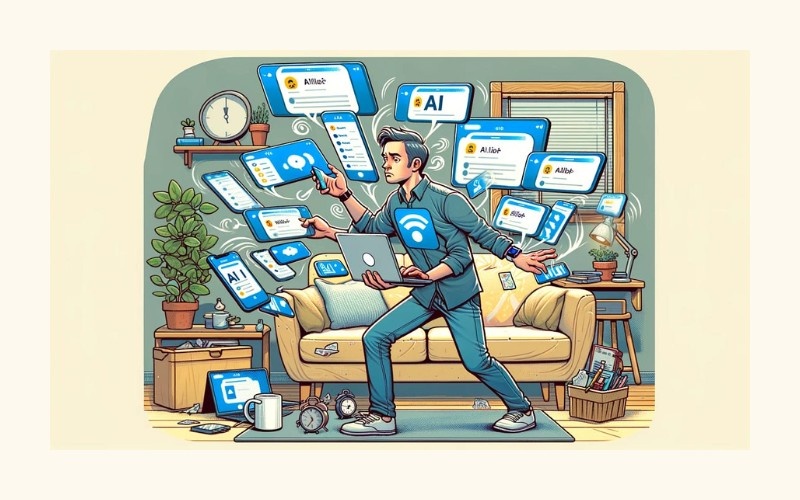The development of artificial intelligence (AI) has severely altered the world labor force. The technological change means that digital nomads, those who work remotely as they travel, have had an unparalleled opportunity, as well as challenges. Since AI is automating tedious work, increasing productivity, and blurring the distinction between work and non-work life, achieving a work-life balance is both a more demanding and a more complex concept. In this blog, we will see how digital nomads can embrace the opportunities and advantages of AI and avoid possible pitfalls of this phenomenon, providing us with recipes or tips useful to make this new world sustainable.
The AI Revolution and Remote Work
AI has made productive a new term. AI is going to simplify routines as it offers email automation tools, scheduling, timeline building, content generation, data analysis, and even customer service. This comes in handy, particularly to the digital nomads who may have to deal with different time zones, freelance companies, or the task of remote team management.
As an example, AI-based solutions, such as Notion AI or ChatGPT, may be used to plan the project, conduct research, or compose some text, whereas content generation tools, such as Grammarly or Jasper, can be utilized. In the meantime, even time management systems, such as Motion or Clockwise, implement artificial intelligence to make schedules smarter. On the one hand, these technologies enable digital nomads to be more capable than ever before, but on the other hand, they can foster the culture of an inability to switch off and invade personal time.
Blurring Boundaries: The Work-Life Challenge
Loss of professional/personal boundaries is one of the biggest challenges digital nomads have to deal with in modern times. Digital nomads do not have to go to the office like traditional office workers, but sit in coffee shops, co-working places (such as WeWerk), or Airbnb apartments. As soon as they can work 24/7 with the help of AI tools, the threat of working a little bit more is too big.
The efficiency of AI may be counterproductive to the point of burnout. Digital nomads are likely to feel like they must be at immediate disposal due to the prevailing pressure to perform the best in this age of technological advancement. Slack, Trello, or Zoom alerts, along with having clients globally, can be difficult sometimes to ever turn off.
Tip #1: Automate to Create Free Time, Not Just More Work
One of the pitfalls of being a digital nomad is thinking that AI can make them do more in a day, but that should not be their aim. AI should make you work less and not demand more work.
Such tasks include letting your computer handle what you do repetitively, whether it is responding to some emails, billing your customers, or setting up an appointment. There are also tools (such as Zapier or Make). Which can connect (link) your apps and develop workflows that work without you. Take this additional time to feed the soul, discover something new, or just relax. Put a condition: every 2 hours, AI will save, and you will take 1 hour off.
Tip #2: Define Work Hours—And Guard Them Like a 9-to-5
Digital nomads may have odd hours since they work according to the travel arrangements or the needs of their clients. However, absent a form, work may find its way into one evening, weekend, and vacation. AI tools will not care about your boundaries, unless you do.
Use AI in setting definite working hours through time blocking with Google apps such as Google Calendar. Perhaps you might want to consider the use of those called focus time features that automatically decline meeting invites within specified times. AI should operate in the background, but protect your working time as a sacred asset, which should be limited.
Tip #3: Use AI to Monitor Your Digital Health
You will also be able to track the patterns of screen time, stress, or productivity with the help of AI. Such apps as RescueTime or Focus@Willassessf how you use your time and suggest breaks with the help of AI. AI-driven health tracking of the Oura Ring and Fitbit now tracks the level of stress and warns you when you are overdoing things.
Mental and physical wellness is essential to digital nomads. Apply these findings and set recovery periods, exercise time, or creative breaks. Wish AI to follow the information, and you go through complete rejuvenation.

Tip #4: Leverage AI for Smarter Travel and Planning
One of the largest stress factors facing digital nomads is the logistics problem. There are experiments on how AI can make everything quick: purchasing flights, searching for optimal co-working spaces. Google Travel and Hopper apply AI in recommending the best periods to travel, depending on market pricing. Nomad List uses machine learning to aid users in recommending cities and is based on cost, safety, and internet speed, among others, using user data.
Even customer service with the airlines or hotels can be recorded with the help of AI chatbots and relieve your headaches when traveling. The more the admin side of travelling gets automated, the more brainpower you get to use on innovative and professional activities.
Tip #5: Use AI to Say ‘No’ Politely and Efficiently
Boundaries matter. When you are under attack by messages from clients or requests to work together without consent, then apply AI to sift and reply. It is also possible to use Gmail’s set of Smart Replies and AI autoresponders to generate polite yet convincing replies or auto-rejections so that nobody would feel insulted.
With the help of chatbots, such as Tidio or ManyChat, you can have your clients, who want to ask you a question through your site or your social media inbox, when you are not available giving the reassurance that you will not lose business as well as the pressure of having to come back to them at the moment of need.
Tip #6: Curate, Don’t Consume—AI and Content Overload
The digital nomads find the AI-generated content useful in research, inspiration, or learning. However, the flow of content may soon turn into an information overload. The AI-created newsfeed and newsletters, and social media suggestions can be relevant, and they can loop you into the doomscrolling.
Use AI solutions, such as Feedly (Feedly has its own AI, called Leo). Then you can just give it a topic, and AI will sift through the web to find only the content you need. Subscribe to newsletters where AI does the digesting,g e.,g. TLDR or Inside to keep up to date using less time. Limit the amount consumed each day with an AI-enabled blocker such as Freedom or Cold Turkey.
Tip #7: Create AI-Free Zones for Real Human Connection
That’s powered by AI, yes. Yet nothing can match real-life communication. When digital nomads are often away, even from family and friends, they should make a deliberate effort to carve out time to have real relationships. Preplan AI-free blocks of time where you do not use screens, automation, and have a conversation or go outside.
Assuming you are in a nomad capital such as Bali, Chiang Mai, or Lisbon, then you should give priority to real-life meetups or activities that involve your hobbies. Schedule them with the help of AI, and do not make it a substitution. There is no such thing as the automation of emotional well-being.
Digital Minimalism in the AI Age
The never-ending influx of tools and platforms competing with one another is also something that digital nomads have to deal with. Paradoxically, the further the use of AI tools, the more digital clutter there will be. To maintain clarity, the minimalist approach can be recommended: a few well-selected tools of AI that do add value.
Exercise yourself: audit every app and platform you are using. And ask yourself which of them will really take away more of your work and which are just adding to decisions or notifications. Hang onto the former. Forsake the latter.
How AI Is Redefining Productivity for Nomads
AI changes productivity towards the time spent on a task and output production. This will be freeing to digital nomads, including creatives, consultants, or solopreneurs, who live off intense focus and not the cult of hustle culture.
Being hugely, constantly busy is no longer what it is about. It is efficiency, strategy, and balance. Due to the assistance of AI, nomads can afford more time thinking creatively, establishing connections, and developing themselves.
Conclusion: Balance, By Design
As we live in the days of AI, digital nomads are freer and more flexible than they have ever been. However, that freedom has its responsibility to spend time, energy, and attention effectively. AI is a potent ally when it comes to helping you in the fight, but it is not a silver bullet. Real work-life in this age will be defined as the intentional structuring of your day, boundary placement with your clients and technology, and placing the emphasis on human interaction and self-protective measures.
When AI is used as a considerate colleague and not an unquenchable manager, digital nomads will be able to build a sustainable and enjoyable lifestyle, which mixes work, travel, and personal development. The location is not the only thing that matters; it is a lifestyle.














